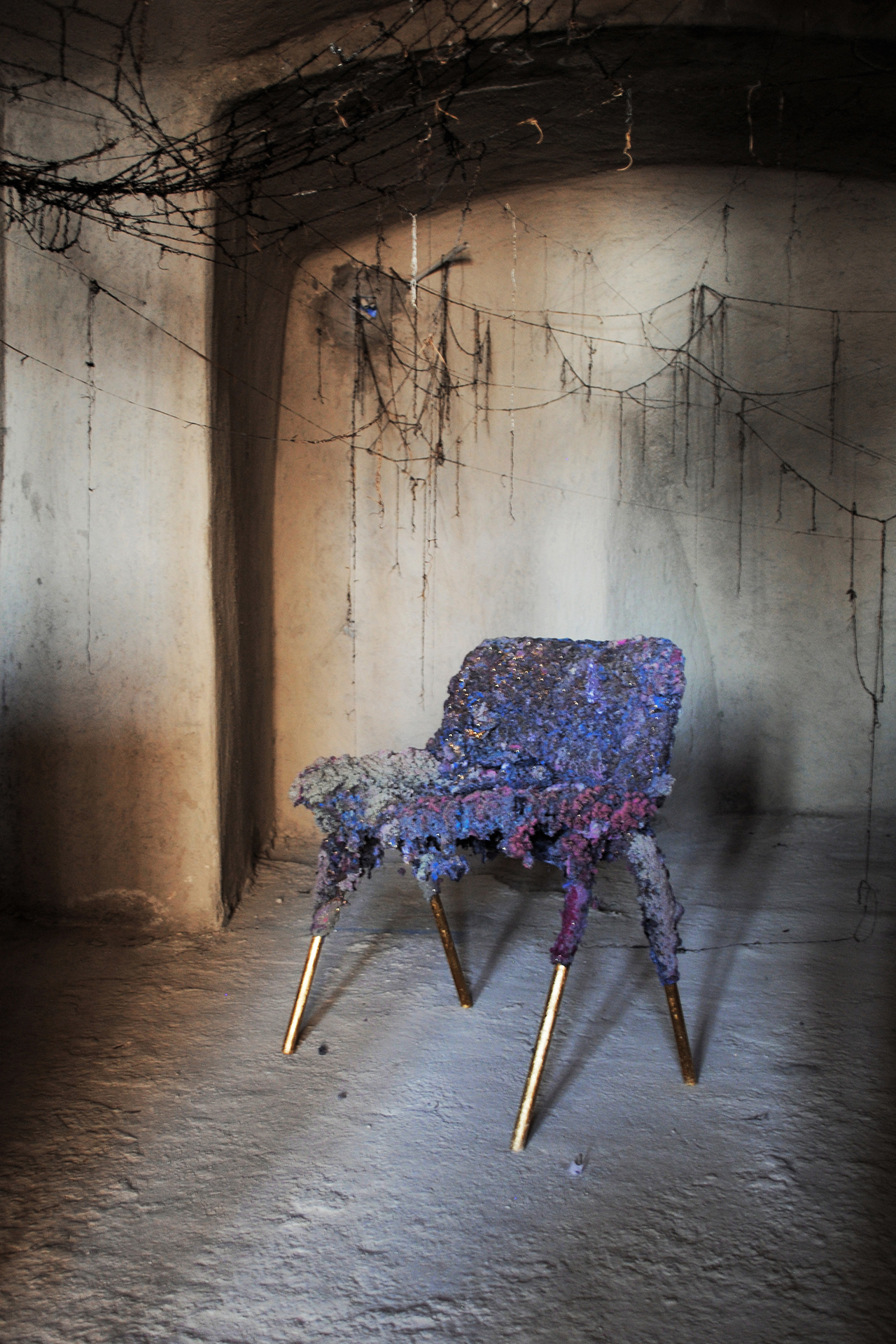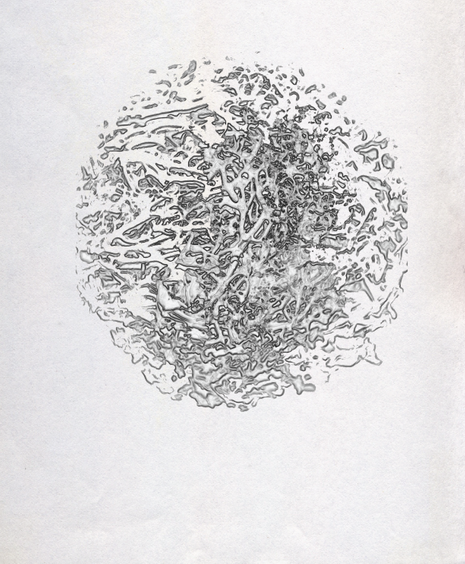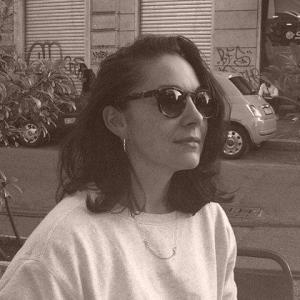Lina Patsiou approaches the design world head-on.
Poetry in Motion
-
Materials for a Forever clock
Courtesy of Lina Patsiou
-
Forever clock
Courtesy of Lina Patsiou
-
Tanning the Forever table and chair
Courtesy of Lina Patsiou
-
Forever table and chair
Courtesy of Lina Patsiou
-
© Bea De Giacomo for L'AB/Pamono
-
Forever clocks
Courtesy of Lina Patsiou
-
Nylon Chair detail
Courtesy of Lina Patsiou
-
Lina Patsiou in conversation with Anna Carnick
© Bea De Giacomo for L'AB/Pamono
-
Nylon Chair
Courtesy of Lina Patsiou
-
A Dream's Taxonomy book
Courtesy of Lina Patsiou
-
Lina Patsiou
© Bea De Giacomo for L'AB/Pamono
She’s half walking, half running as she makes her way down a sleepy Milano side street—a dark and lovely figure wearing a huge smile. Lina Patsiou, recent RCA grad and rising design talent, is taking a break from prepping her latest exhibition in nearby Ventura Lambrate to meet for lunch and a springtime walk along the Naviglio canal.
As she zooms towards me, I imagine this must be the primary pace she’s maintained for the past two years. In that time, the Greek-born, London-based designer has established her own studio; graduated from one of the world’s premier design schools; released two impressive design series; and frequently exhibited her work at events in Milan, London, Istanbul, and beyond. Last October, the Elle Decoration International Design Awards even nominated her for Young Designer Talent of the year. There’s no denying it; Patsiou’s on the move.
However, as we sit together canal-side at Officina 12, preparing to inhale trayfulls of charcuterie, it’s clear within moments that despite her go-go-go lifestyle, Patsiou’s maintaining her balance. Intensely observant and adroit, there’s also a dreaminess to her persona, perhaps even a bit of the poet’s spirit.
Describing her work thus far, Patsiou notes with a far-away look, “After a few projects you see a pattern emerge, and you understand better your practice and yourself. I am interested in the moments in life that make us who we are—both as a personal interest and a professional one. These are the moments you see when you close your eyes; different versions of yourself at various ages in different situations, be they important or trivial, but all very, very you. I am intensely interested in those moments; it’s what life is, and where identity comes from.”
Patsiou’s designs often begin from a very conceptual point, which is translated into a lyrical version of an everyday object. Her furniture, objects, and installations explore the concepts of time and identity, and, in particular, the ways objects absorb traces of the environments in which they exist. As she says, “I try to imagine the situations that they will witness. And then I either design them to absorb them, to record them, or to represent them.”
The beautifully handcrafted Forever series, for example, is an ongoing collection that began as Patsiou’s graduation project and includes a leather-upholstered metal table and chair and—as of this year—a trio of leather-upholstered, wooden wall clocks. The table and chairs alone incorporate over five meters of hand-stitched details. Each piece has been strategically exposed to UV light in order to create decorative “tan lines.” As time passes—since the leather is still photosensitive—the pieces’ pigmentation will continue to evolve, all depending on how and where the pieces are used. Keep a Forever piece in the shade to delay it from getting darker, or even cover it up completely to preserve it. Or, if you’re game, as Patsiou says, “Put it where you want it, uncovered, to admire its beauty; give yourself the luxury of using it. Put your pens and papers on it and leave them; Forever will change completely. It will still be a leather-covered table of exquisite quality and craft, but it will have the lines of time on it—it will become a snapshot of each of your working days. But it will be yours in a very personal way.”
Similarly, Patsiou’s earlier Nylon Chair project also bears witness to the world in which it resides. Here, Patsiou leaves a chair inside the flocking booth of a flock-coating manufacturer; with each of the company’s projects, residue accumulates on top of the chair; the busier and more successful the company has been during a given timeframe, the more substantial the resulting chair’s form will be.
The Forever collection and the Nylon Chair are just two examples of Patsiou’s interest in adding some poetry back into the everyday. The notion of memory—the logical partner of time and identity—comes up again and again in her work as well. Memory is at the forefront of A Dreams Taxonomy, for example, Patsiou’s very first project as a student at the RCA studying under designer Tord Boontje. “Practically my first day in school, Tord gave us an envelope that contained a transparent piece of paper and a sleeping mask. The paper read, ‘It started with a dream,’ and that was our brief! It was my first week at the college, and getting there was already a dream for me. So I made my first project all about going after your dreams—and grasping them.
A Dream’s Taxonomy considers the idea that dreams are living organisms, and going after them before they escape from one’s memory “is like hunting for them,” Patsiou explains. Thus, she created an encyclopedia-like book full of illustrations and scientific descriptions of organisms inspired by dreams, such as where they are found, what they feed on, how they procreate, and so on. From these drawings, she composed 3D-printed organisms, which were then presented, trophy-like, in glass and wooden boxes a la something out of a natural history museum.
Patsiou is also very conscious of the role that growing up in Greece plays in her work today. “Being from Greece definitely influences my work, particularly in terms of navigating space. There, you’re constantly moving towards the sun or shade; in my mind, Athens’ landscape is defined by light in a way—there are sunny patches that are beautiful, and others that are so bright they’re blinding; so you move to the shade to protect yourself. But maybe the darker areas get too dark, and then you move. I think this ongoing navigation has definitely influenced me.”
Asked to recall when she first recognized her interest in objects and spaces, Patsiou recounts a somewhat peculiar (but completely amusing) childhood game. “I’ve always been drawn to the way objects interact in space. When I was little, my parents and I spent our summers on the island of Lesbos with my grandparents. All of my family—my grandparents, my parents, my uncle and aunt and my cousin, would take a siesta in the family home each afternoon, for maybe two hours. I never got used to it, so for two hours I had nothing to do, so I’d rearrange the furniture while everyone slept—and then put it back before they woke up. Sometimes I’d leave something slightly changed just to see if someone would notice,” she says, shaking her head and laughing.
Today, she’s quite happy for others to see her work—although she still wants it to be done just right. Since graduating last spring, Patsiou’s worked out of a Hackney-based studio shared with three other RCA grads. In that period, she says, “I’ve taken the opportunity to really think about exactly what I want professionally. It’s very important for me now to see how I can support the ideas I have, rather than just going into a frenzy of making more. I think that’s a common designer trait, and I’m guilty of that sometimes. You have an idea and you can’t keep it in; but that can also mean that you might not have the time to properly promote or communicate the work or find it the proper home, whether that’s a gallery, a shop, or an actual house. It’s important to organize and think about just what you want to achieve.”
And while her career continues to speed up, Patsiou is learning it’s okay to take things in her own time. “To do things right takes patience; I’m learning that I don’t need to rush.”
-
Text by
-
Anna Carnick
Anna is Pamono’s Managing Editor. Her writing has appeared in several arts and culture publications, and she's edited over 20 books. Anna loves celebrating great artists, and seriously enjoys a good picnic.
-
-
Portrait Images by
-
Bea De Giacomo
Based in Milan, Bea is a charming and talented photographer whose clients include Wallpaper*, Hunter, Interview, DePadova, and Yoox. Since 2011, she's also served as photo editor at Vice Italy.
-












 Nylon Chair
Courtesy of Lina Patsiou
Nylon Chair
Courtesy of Lina Patsiou
 Sketch for A Dream's Taxonomy
Courstesy of Lina Patsiou
Sketch for A Dream's Taxonomy
Courstesy of Lina Patsiou

